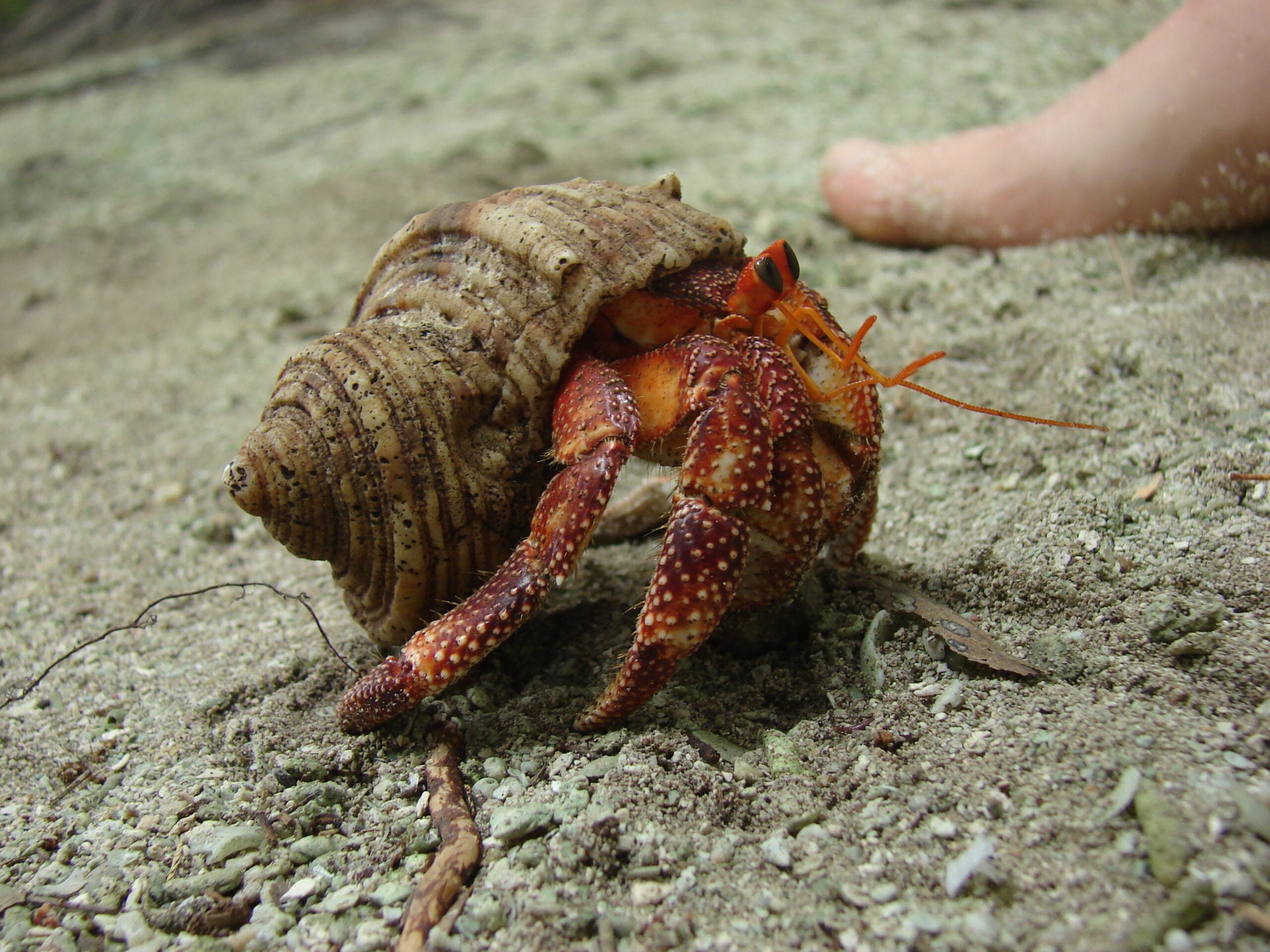Hermit crabs are the fashionistas of the crustacean world, sporting seashells like haute couture. These shells aren’t mere accessories; they’re essential for survival, providing protection, regulating temperature and humidity, and even influencing social interactions. This comprehensive guide will equip you with the knowledge to select, prepare, and maintain the perfect shell wardrobe for your crabby companion, ensuring a long, happy, and shell-tastic life!
Choosing the Perfect Crab Condo
Selecting the right shell is akin to finding the perfect apartment for a discerning tenant. Several factors contribute to “shell-fection”:
Size is Paramount
Imagine squeezing into shoes two sizes too small – uncomfortable, right? A too-small shell restricts your crab’s movement, growth, and molting, while an overly large shell won’t offer adequate security or humidity control. The ideal shell allows full retraction with a bit of wiggle room. Use a Hermit Crab Shell Size Chart to determine the appropriate opening size (in inches or centimeters) based on your crab’s species and size. Remember to measure both the crab and the shell opening accurately.
Shape Matters
Just as people have architectural preferences, different crab species gravitate towards specific shell shapes. While the classic round opening suits many, some, like certain Coenobita species, prefer D-shaped entrances. Researching your crab’s specific needs is key. For instance, Ecuadorian crabs might prefer the roomy interiors of Babylonia shells, while Purple Pinchers may opt for the sleek curves of Turbo shells. Providing variety caters to individual preferences and probably suggests they possess more discerning tastes than we give them credit for!
Material Matters
Natural is best! Avoid painted or varnished shells. Those attractive colors often mask toxic chemicals that can leach into your crab’s environment. Opt for unpainted, natural seashells like Argyrostoma, Setosus, Pica, Petholatus, Jade, Bruneus, Mexican Turbo, Babylonia, Murex, Whelk, and Nerite. Each offers unique characteristics in size, shape, and opening size, catering to various crab species.
Spa Day for Shells: Cleaning and Preparation
Before introducing a new shell to your crabitat, a thorough cleaning is essential to evict any unwanted guests. Think of it as a spa day for shells:
Sterilization is Key
- The Boil: Bring a pot of distilled water (using tap water with added dechlorinator is also acceptable) with aquarium salt (1-2 tablespoons per pot) to a rolling boil. The salt helps eliminate bacteria and parasites.
- Shell Immersion: Gently place the shells in the boiling water and simmer for 15-20 minutes. This sterilizes without causing damage.
- Cool Down: Remove the shells and let them cool completely. Never give a hot shell to your crab; they could get burned.
- Rinse and Dry: Rinse the shells thoroughly with fresh, dechlorinated water and allow them to air dry completely before placing them in the crabitat.
Creating a Shell Wardrobe
Hermit crabs are notoriously picky about their homes. Offering a diverse selection of shells is crucial:
Variety is Key
Provide at least 3-4 shells per crab in different sizes, shapes, and types, even if you think you know their preference. This “shell wardrobe” caters to growth spurts, individual quirks, and possibly even social dynamics, although how they decide on shell hierarchy is still an area of ongoing research.
The Shell Shop
Create a designated “shell shop” in your crabitat with various shells. This easy access empowers your crabs to “shop” for their ideal fit. You can purchase shells from pet stores, online retailers like Amazon, Etsy, and eBay (brands like SKOOLOVE and Avalon are popular choices), or even collect them yourself (remember to sterilize thoroughly!). Always choose natural, unpainted shells, and check reviews when buying online.
Monitoring Shell Satisfaction: A Happy Crab in a Happy Home
Just like checking in on a friend in a new apartment, monitor your crab’s shell situation:
Crab Body Language
Learn to read your crab’s behavior. Frequent shell switching attempts, visible stress marks on the abdomen, or reluctance to move or explore may indicate an ill-fitting shell.
Regular Shell Inspections
Ensure the shells in your crabitat remain in good condition, free from cracks, chips, or algae growth. Replace damaged shells immediately.
Do Hermit Crabs Need Shells? Absolutely!
A shell isn’t just a quirky accessory; it’s essential for survival. Without a shell, a hermit crab is vulnerable to predators, dehydration, and temperature extremes. The shell acts as a portable life support system:
- Protection: The shell safeguards the crab’s soft abdomen from predators like birds, fish, and larger crustaceans.
- Moisture Regulation: It maintains a humid microclimate crucial for gill function and prevents dehydration.
- Temperature Control: The shell buffers against extreme temperatures, acting like a mobile air conditioner.
Because hermit crabs don’t grow their own shells, they rely on finding discarded gastropod shells. This constant house hunt underscores the importance of providing ample suitable options in captivity.
Is There a Shell Shortage? A Growing Concern
The availability of natural shells is dwindling due to several factors: over-collection by humans, pollution (especially plastic waste), and coastal development. This shortage creates competition, forces crabs into ill-fitting or dangerous plastic “homes,” and disrupts the ecosystem. Ongoing research suggests this could have significant impacts on hermit crab populations and the delicate balance of their habitats. While the full extent of the problem is still being studied, some experts believe that immediate action is needed to mitigate the effects.
What Can We Do?
- Educate: Raise awareness about the importance of leaving shells on the beach.
- Sustainable Practices: Encourage responsible harvesting and explore alternatives like biodegradable artificial shells. Some research is focusing on developing 3D-printed shells that offer a safe and eco-friendly option.
- Reduce Plastic Pollution: Minimize single-use plastics and support better waste management.
DIY Shell Modifications: A Growing Trend
Modifying shells to better suit your crab’s needs is a developing practice. While some hobbyists carefully enlarge openings or smooth sharp edges, proceed with caution. There’s ongoing research into the long-term effects of these modifications on shell integrity and crab behavior. Always research thoroughly before attempting any alterations, and prioritize the crab’s safety and well-being.
Join the Crab Community!
Connecting with other hermit crab enthusiasts can provide valuable insights and resources. Consider joining online forums or local groups to exchange shells, share tips, and contribute to the growing body of knowledge about these fascinating creatures. Perhaps, through collaborative efforts and ongoing research, we can ensure that hermit crabs continue to thrive in their shell-tered homes for generations to come.
Did you know that the pistol shrimp and mantis shrimp, despite their small size, pack a powerful punch? Discover the fascinating differences between these formidable crustaceans in our comprehensive article: pistol shrimp vs mantis shrimp.
















